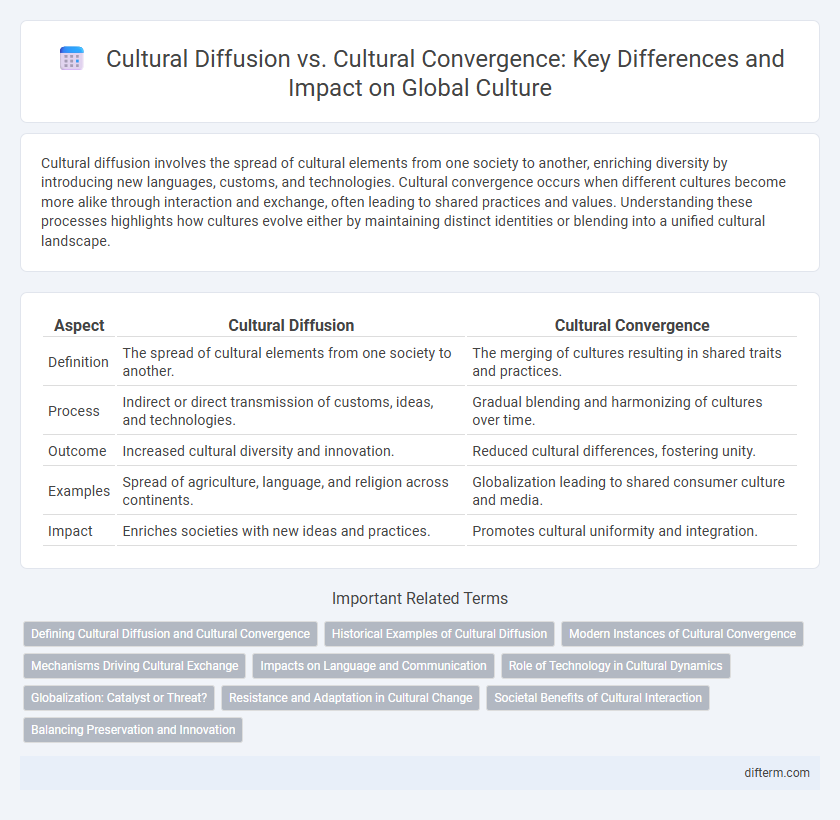Cultural diffusion involves the spread of cultural elements from one society to another, enriching diversity by introducing new languages, customs, and technologies. Cultural convergence occurs when different cultures become more alike through interaction and exchange, often leading to shared practices and values. Understanding these processes highlights how cultures evolve either by maintaining distinct identities or blending into a unified cultural landscape.
Table of Comparison
| Aspect | Cultural Diffusion | Cultural Convergence |
|---|---|---|
| Definition | The spread of cultural elements from one society to another. | The merging of cultures resulting in shared traits and practices. |
| Process | Indirect or direct transmission of customs, ideas, and technologies. | Gradual blending and harmonizing of cultures over time. |
| Outcome | Increased cultural diversity and innovation. | Reduced cultural differences, fostering unity. |
| Examples | Spread of agriculture, language, and religion across continents. | Globalization leading to shared consumer culture and media. |
| Impact | Enriches societies with new ideas and practices. | Promotes cultural uniformity and integration. |
Defining Cultural Diffusion and Cultural Convergence
Cultural diffusion refers to the spread of cultural elements such as ideas, styles, religions, technologies, and languages from one society to another, resulting in increased cultural diversity. Cultural convergence occurs when different cultures become more similar due to shared influences, often through globalization, technological advancements, or communication networks. Both processes play crucial roles in shaping cultural landscapes by either blending distinct traditions or promoting homogenization across societies.
Historical Examples of Cultural Diffusion
The Silk Road exemplifies cultural diffusion by facilitating the exchange of goods, ideas, and technologies between East Asia, the Middle East, and Europe, blending diverse traditions and knowledge. The spread of Buddhism from India to East Asia highlights how religious beliefs and practices transcended regional boundaries through trade routes and missionary activities. These historical examples underscore how cultural diffusion promotes multiculturalism and innovation by merging distinct cultural elements into new, hybrid forms.
Modern Instances of Cultural Convergence
Modern instances of cultural convergence are evident in global phenomena such as the widespread adoption of social media platforms, international music collaborations, and fusion cuisines that blend diverse culinary traditions. These examples showcase how digital communication technologies and increased global mobility facilitate the merging of distinct cultural elements into shared experiences. Brands like Spotify and Netflix exemplify cultural convergence by curating and distributing content that appeals to diverse international audiences, fostering a global cultural marketplace.
Mechanisms Driving Cultural Exchange
Cultural diffusion occurs through mechanisms such as migration, trade, and communication technologies that enable the spread of ideas, customs, and innovations across societies. Cultural convergence involves the blending and homogenization of cultures driven by globalization, mass media, and multinational corporations facilitating shared values and practices. Both processes rely on interactions that reshape cultural landscapes and influence identity formation worldwide.
Impacts on Language and Communication
Cultural diffusion accelerates linguistic diversity by introducing new words, dialects, and communication styles across regions, enriching languages with borrowed elements. Cultural convergence tends to standardize language and communication methods, often promoting a dominant language and reducing linguistic variety. Both processes significantly influence how language evolves, either by expanding its expressive capacity or by streamlining communication across cultures.
Role of Technology in Cultural Dynamics
Technology accelerates cultural diffusion by facilitating the rapid exchange of ideas, customs, and innovations across global networks, enabling diverse cultures to interact and adopt elements from one another. Simultaneously, technology drives cultural convergence by standardizing communication platforms, entertainment, and consumer products, which fosters shared experiences and diminishes cultural distinctions. The interplay of digital media, social networks, and transportation technology profoundly shapes cultural dynamics, influencing how societies evolve and integrate.
Globalization: Catalyst or Threat?
Cultural diffusion accelerates through globalization by spreading ideas, technologies, and customs across borders, fostering diversity and innovation worldwide. Cultural convergence, driven by global media and trade, often leads to homogenization, potentially eroding unique cultural identities and traditions. The balance between diffusion as a catalyst for multicultural exchange and convergence as a threat to cultural distinctiveness shapes the ongoing global cultural landscape.
Resistance and Adaptation in Cultural Change
Cultural diffusion involves the spread of cultural traits across societies, often encountering resistance as communities strive to preserve traditional values and identities. Cultural convergence, on the other hand, emphasizes the adaptation process where diverse cultures blend, leading to the emergence of shared practices and norms while simultaneously prompting selective acceptance or rejection of foreign elements. The dynamics of resistance and adaptation are crucial in understanding how cultural change manifests, balancing preservation with innovation in global interactions.
Societal Benefits of Cultural Interaction
Cultural diffusion facilitates the exchange of ideas, technologies, and customs among diverse societies, enriching communities with new perspectives and fostering innovation. Cultural convergence leads to shared values and practices, enhancing social cohesion and mutual understanding within and between populations. Both processes promote societal benefits by encouraging collaboration, reducing conflicts, and expanding creative and economic opportunities globally.
Balancing Preservation and Innovation
Cultural diffusion spreads ideas and practices across societies, enriching traditions while challenging preservation. Cultural convergence blends distinct cultures into shared experiences, driving innovation but risking loss of unique identities. Balancing preservation with innovation requires promoting heritage education alongside adaptive creativity to sustain cultural diversity amid globalization.
Cultural diffusion vs Cultural convergence Infographic

 difterm.com
difterm.com